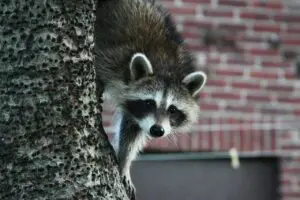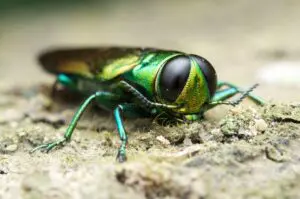
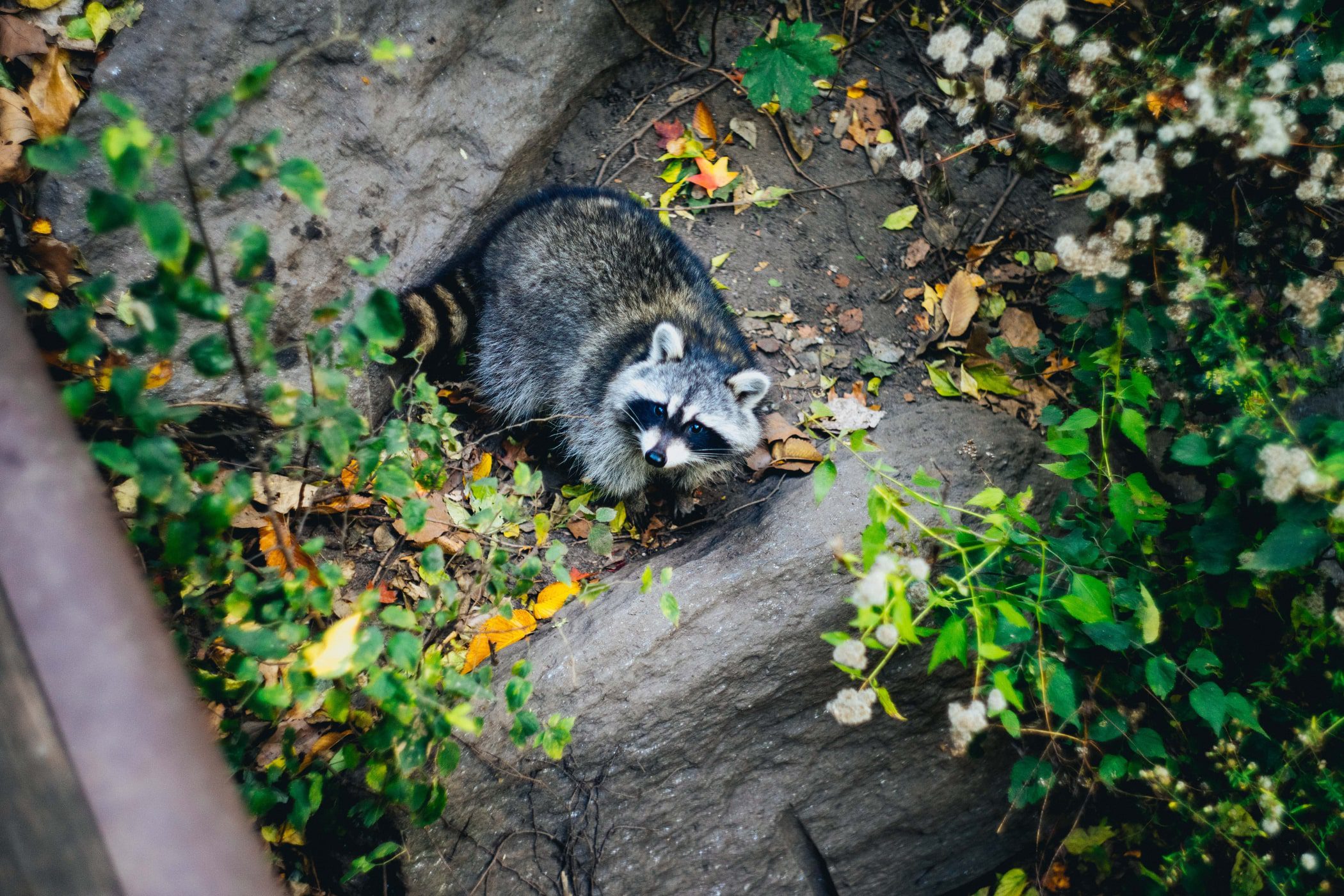
- Understanding the Need for Wildlife Proofing
- The Importance of Professional Wildlife Proofing
- Identifying Common Pests and Nuisances
- Wildlife Behavior: How They Gain Entry
- Health Risks from Wildlife Pests
- Property Damage: A Costly Consequence
- Choosing the Right Wildlife Proofing Service Provider
Understanding the Need for Wildlife Proofing
Wildlife proofing has become more necessary with wildlife’s natural habitats being diminished due to fires and even building in their space. These critters often have had no choice but to move closer to human dwellings and have close contact with us in search of food and shelter.
Wild animals will use opportunities created by people who unintentionally make their homes and properties appealing to wildlife pests. Therefore, it is safer to wildlife-proof buildings and properties to help minimize any interactions and conflicts with wild animals.
The Importance of Professional Wildlife Proofing
Having access to professional wildlife proofing services is important in helping to reduce the spread of diseases by eliminating human contact with the wildlife pests and protecting you from attacks by wild animals.
Additionally, these services can help in preservation of your property because animals that are not properly controlled can cause damage to buildings and other structures, contaminate food and water supplies.
Identifying Common Pests and Nuisances
Squirrels: The Agile Intruders
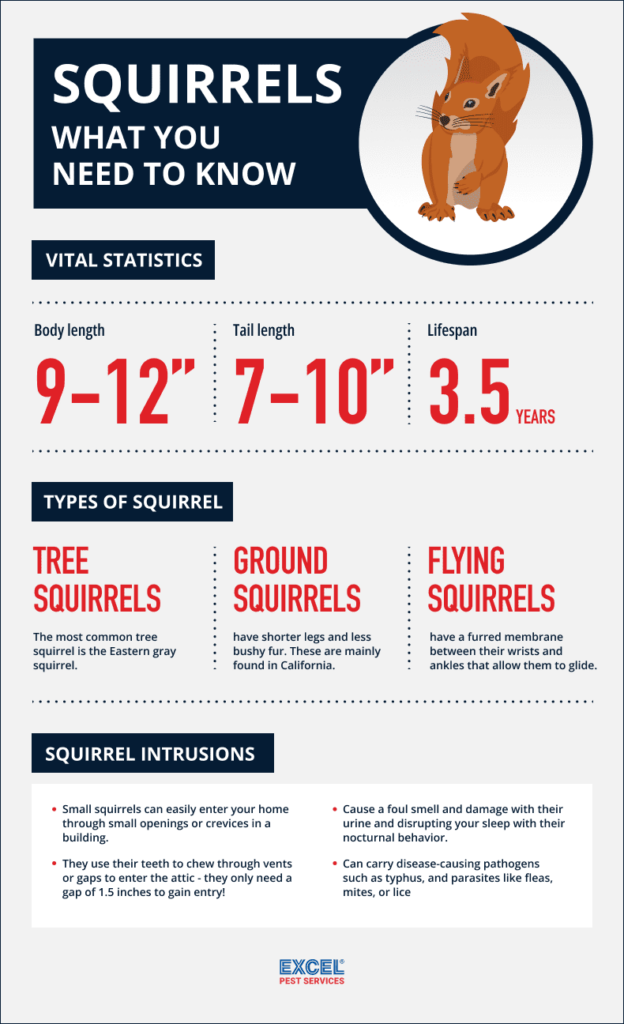
The United States is home to three different types of squirrels; tree, flying and ground. Some live in the trees, some live in the ground and others appear to fly. Tree squirrels generally have bushy tails, sharp claws and large ears, while ground squirrels have shorter legs and less bushy fur. Flying squirrels have a furred membrane between their wrists and ankles that allow them to glide between trees.
Tree squirrels are named after their common habitat - the woods. These are the typical squirrels you might observe darting around your yard, often hiding acorns and other edibles for future use. Their fur varies in shades from a reddish-brown to gray, and their fluffy tails make them easily recognizable.
Tree squirrels make their homes, evade predators, and collect food in areas abundant with foliage. If they manage to infiltrate your house, squirrels can create numerous problems, including sounds in the attic and walls, punctures in the siding, ruined bird feeders, gnawed wires, and destroyed attic insulation.
Many species of ground squirrels live in the United States. These small rodents prefer to dig burrows in open habitats such as prairies. Due to destructive burrowing and chewing, these species can sometimes cause great damage to gardens.
Flying squirrels are tinier than tree squirrels and other squirrel varieties. They stretch the skin flap between their fore and rear limbs to form a kind of parachute, allowing them to leap or glide from one tree to another, creating the impression of flight. Flying squirrels are sociable animals, so if you spot one, there's a high chance that there are others in your house. They usually only try to enter homes when the weather gets colder, looking for refuge during the chilly winter months.
Raccoons: Clever and Persistent
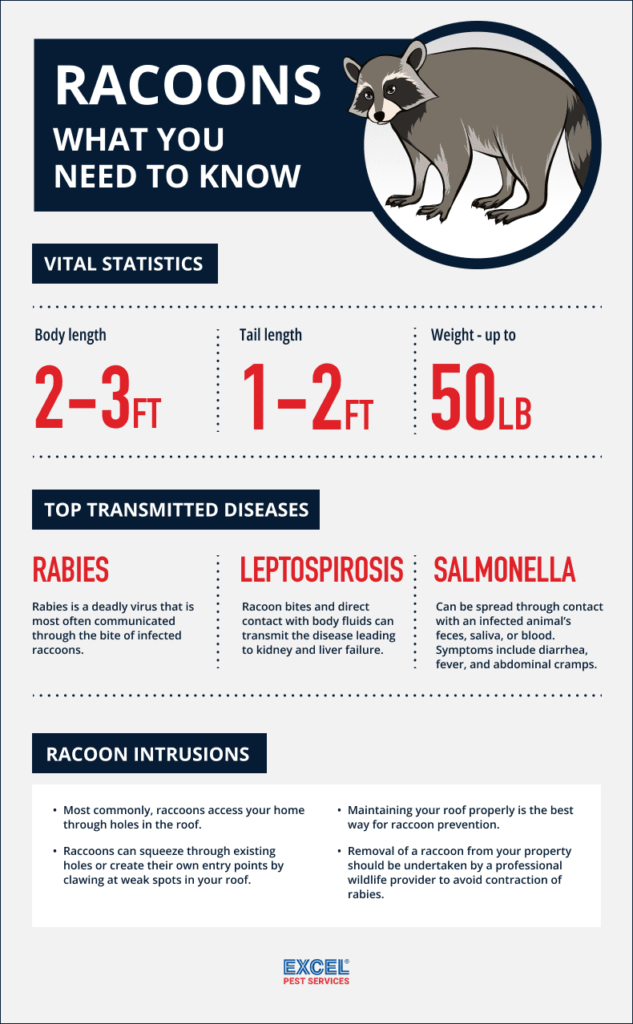
Raccoons are primarily active at night and are rarely spotted during daylight hours. They are easily recognizable by their characteristic gray coat and a black band around their eyes, giving them a masked appearance. Raccoons also possess fluffy, ring-patterned tails and paws that look like small, clawed hands. They are widespread across the U.S., but their population is denser in the forested eastern regions compared to the arid western lowlands.
These creatures have a diverse diet, consuming everything from berries, nuts, insects, mice, eggs, to even snakes. They are also known for their habit of scavenging dumpsters and trash bins for leftovers.
Raccoons can become a problem if they invade your home, creating loud sounds and spreading garbage. They are also notorious for damaging walls and floorings. If you have a raccoon presence outdoors on your premises, you might notice evidence of these creatures like feces (which could carry parasites and be hazardous to people), along with distinctive footprints or scratch marks on patios, garden furniture, walls, or close to drain pipes and gutters.
Birds: From Chirping to Nuisance
Sometimes, birds make their way into buildings, where they can become a nuisance due to loud noises, structural damage, and messes. Birds are an important part of our natural environment, playing a key role in seed dispersal, plant pollination, and even pest removal.
One of the most common birds that can be a pest are pigeons, which can be found almost everywhere, from rural dwellings to city areas. They produce a significant amount of excrement that is not only odorous and unattractive, but can also accelerate the rate of building decay. Furthermore, their feces can harbor disease-causing agents that may lead to histoplasmosis, an infection in humans that can result in fever, cough, and tiredness.
To discourage pigeons from settling on or around your house, it's crucial to remove any sources of food and water. Pigeons are innate foragers and might rummage through your garbage for sustenance. Ensure your trash is securely bagged and that the lids on your trash cans are tightly sealed to stop them from accessing it. Likewise, if you dine outside during the hotter months, make sure to correctly discard any dishes or containers that might hold food appealing to pigeons.
Sparrows are another bird species that tend to nest in and around human-populated structures, contributing to noise pollution. These avian creatures can present multiple fire and health hazards due to their incessant pecking at structures, along with their excrements that might harbor disease-causing pathogens.
Bats: Silent Flyers in the Night
Bats are night-active, airborne animals that favor residing in dim, secluded areas. The CDC identifies bats as the primary source of rabies fatalities in humans within the US. Besides the threat of rabies, the fungus present in bat droppings can trigger histoplasmosis, a pulmonary disease.
Bats may be drawn to deceased trees in your garden and can infiltrate your house via open windows, fireplaces, or any openings or fissures in your rooftop or cladding.
Rodents: Unwelcome Guests Indoors
Rodents are warm-blooded mammals that are found throughout the world. Some of the most common invaders in the rodent family are rats, mice, squirrels, and chipmunks.
Different species of rodents exhibit significant variations in appearance, yet all rodents possess oversized front teeth that they use for chewing. Rodents are hard to control and their chewing habit can cause a lot of damage in and around the house. Rodents carry and spread fleas, as well as diseases, including Hantavirus, Monkeypox and Tularemia amongst others.
Insects: Crawlers and Flyers
Bees are some of the most useful creatures not only to humankind but the ecosystem as a whole. Besides being honey producers, bees also pollinate flowers. The most common types of bees that home and property owners come across are honey bees, carpenter bees, and bumble bees.
In nature, bees nest in trees and logs. When given access to homes, the pests construct hives in walls, attics, or crawl spaces. Ground-dwelling bees search for large, undisturbed patches of dry soil. They prefer lawns with minimal plant growth, as they use these areas to create tunnels and lay their eggs.
Preventing pests from getting into your home or property is better than dealing with them later. Bee prevention can be as simple as removing flowers like sunflowers, coneflowers, goldenrod, and clovers from gardens and flowerbeds, which attract bees. Seal off exterior cracks to your home and be sure to replace broken window and door screens. Lastly, treat outdoor wood to discourage wood-boring species.
However, should you find yourself at the cure stage then fear not there’s help for you also. Nest and bee removal should strictly be handled by a professional as these passive pests can get aggressive and cause harm when they feel threatened. A professional will be sure to do the removal in a humane way and relocate the insects.
Wildlife Behavior: How They Gain Entry
Squirrel Intrusions: Where and How They Access Homes
Small squirrels can easily enter your home through small openings or crevices in a building, despite being harmless. They use their teeth to chew through vents or gaps to enter the attic. They also use trees or wires to reach the roof. They only need a gap of 1.5 inches to gain entry!
These creatures only turn into nuisances when they inhabit your loft, causing a foul smell and damage with their urine and disrupting your sleep with their nocturnal behavior. Similar to other wildlife, they can carry disease-causing pathogens such as typhus, and parasites like fleas, mites, or lice. Which is why squirrel prevention is necessary, and you can do this by simply doing the following property maintenance:
- Assess your attic during the daytime for any gaps and seal them off.
- Be sure to cap or place mesh on chimneys and vents.
- If there are any tree branches that hang close to or over your house, trim them off to prevent squirrels from easily accessing your roof.
Raccoon Tactics: Breaking and Entering
Most commonly, raccoons access your home through holes in the roof. If there are any existing holes, raccoons can easily squeeze through them. They can also create their own entry points by clawing at weak spots in your roof (plumbing mats, vents, chimneys.
Maintaining your roof properly is the best way for raccoon prevention. Check it regularly for weak spots and replace them as needed. Additionally, you should pay special attention to your roof after a major storm that could have weakened it or formed holes that could provide raccoons with access to your house.
The best method to remove a raccoon from your property is trapping done by a professional wildlife provider, as direct capture by homeowners is dangerous considering that raccoons are a rabies vector species.
Bird Nests and Roosting Sites
Birds can access more property openings than rodents because they can fly and reach higher places. Pest birds prefer window ledges, rooftops, and warehouses as ideal substitutes for roosting and nesting.
Birds roost on the roof of your home or business. They do this because it gives them a good view of food and predators. Equipment on rooftops can attract birds, causing damage from droppings and nesting materials that block drains and vents.
Bat Entry Points: Cracks, Gaps, and Attics
Bats can enter your home through small cracks or openings as small as ⅜ of an inch. First, check roof vents, gables, and ridge caps. If nothing there, look for areas with missing or shifted bricks or a broken window.
Another common place for bats to nest is the attic, where you’ll see bat droppings concentrated most often where you’ll see clusters of bats clinging to or climbing down walls.
Rodent Pathways: Squeezing Through Small Spaces
Rats and mice can fit through small holes. Rats need a gap of half an inch or more, while mice only need a quarter of an inch. Since they are able to collapse their diaphragms this makes it easier to maneuver through small spaces.
Additionally, rodents - unlike other critters that enter through existing weak points of a structure - can create their own entry points. Because of their ever-growing teeth and jaw power, they can and will chew through brick, wood, concrete, and even steel to gain access to your property. Common entry points include poorly fitted pipes, air vents, overgrown shrubbery, doors and drains among other things.
Health Risks from Wildlife Pests
Wild animals are good for the ecosystem. However, they can pose a threat to humans. This is because they are not domesticated and can carry infections and diseases from the wild.
Even though some of these critters may look adorable and harmless, don't be fooled! Many of them are harmful to your property and also your health by transmitting disease. Bats, rodents, and birds are directly involved in the transmission of diseases like salmonellosis, typhus, plague, and Lyme disease. While others may be biters, stingers or cause allergic reactions in the indoor environment.
Rabies Cases in the US
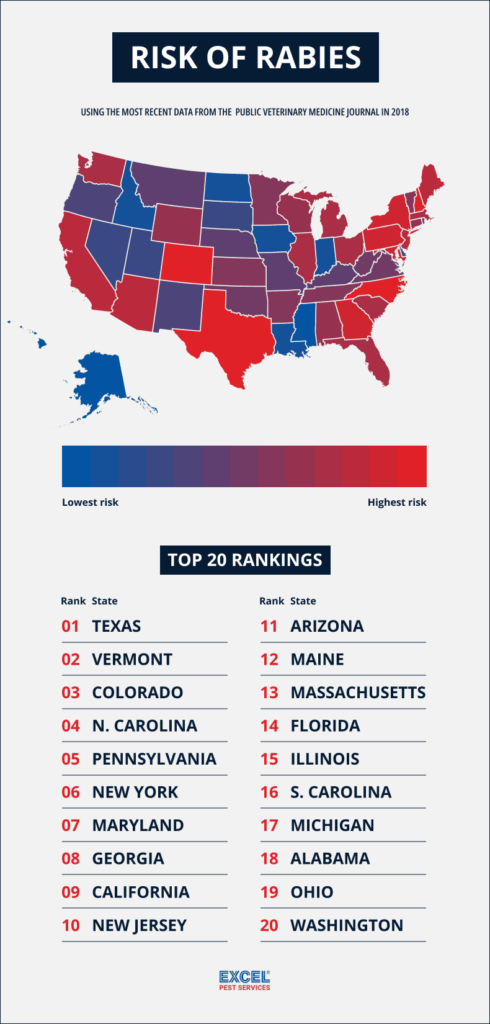
As mentioned earlier in the study, wild animals like racoons also pose a risk for rabies. To dig further into the topic, we examined the most recent data – from 2018 – regarding wildlife rabies cases across the US.
With more than six times the number of rabies cases than the US average, Texas has the most rabid wildlife. The animal which is most infected? Skunks.
Skunks and raccoons are the most rabid animals in 20 states each, especially in sunny areas. Bats carry diseases a lot, especially in Ohio and Washington. But in Alaska, the main carrier is the Arctic Fox, which is different from the other states.
Rabies Cases in New Jersey
According to the most recent comprehensive statistics using CDC data, New Jersey has the 10th highest wild cases of rabies in the US. Yikes! In fact, wild rates of rabies are 115% higher than the national average.
In the Garden State, raccoons are the most likely carriers of rabies, followed by bats and skunks.
Rabies Cases in Florida
Again, using the same data, Florida ranked 12th out of the 50 states for cases of rabies in animals, and 14th for cases of rabies in wild animals. However, despite only finishing 14th, Florida is one of only three states in the study which recorded a human case.
As in New Jersey, the most common animal in the state to have rabies is the raccoon.
Property Damage: A Costly Consequence
With pest infestation one of the most common and costly consequences is that of property damage. Carpenter bees easily cause structural damage, while rodents damage your belongings. Pigeons have dirty droppings that can damage property because of the uric acid in them.
Choosing the Right Wildlife Proofing Service Provider
It’s important to have your house inspected by an experienced professional, so as to determine what you may need in particular seeing as every house is different. A wildlife proofing provider like Excel Pest Services will be able to recognize potential points of entry as well as how to secure them to protect you and your home.
Bear in mind that in choosing the right wildlife proofing service provider for you, you may want to consider a provider that will practice a humane approach to removing wildlife from or proofing your space. So avoid trying to solve the situation yourself even if it may be cost-effective.






